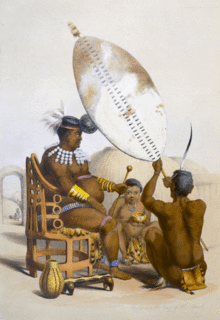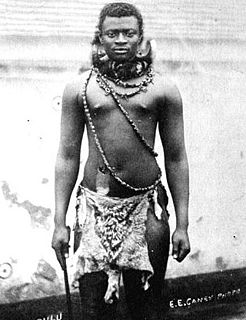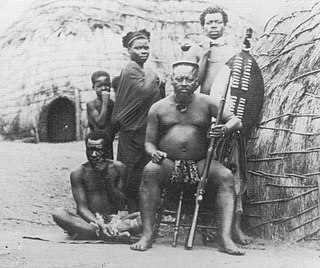Related Research Articles
The Zulu, or also known as Amazulu, are a Bantu ethnic group of Southern Africa. The Zulu are the largest ethnic group in South Africa with an estimated 10–12 million people living mainly in the province of KwaZulu-Natal. The Zulu originated from Nguni communities who took part in the Bantu migrations. As the clans integrated together, the rulership of Shaka brought success to the Zulu nation due to his perfected military policies. The Zulu take pride in their ceremonies such as the Umhlanga, or Reed Dance, and their various forms of beadwork. The art and skill of beadwork takes part in the identification of Zulu people and acts as a form of communication. The men and women both serve different purposes in society in order to function as a whole. Today the Zulu predominately believe in Christianity, but have created a syncretic religion that is combined with the Zulu's prior belief systems.

The Anglo-Zulu War was fought in 1879 between the British Empire and the Zulu Kingdom. Following the Constitution Act, 1867 for the federation in Canada, by Lord Carnarvon, it was thought that similar political effort, coupled with military campaigns, might succeed with the African kingdoms, tribal areas and Boer republics in South Africa. In 1874, Sir Bartle Frere was sent to South Africa as High Commissioner for the British Empire to bring such plans into being. Among the obstacles were the presence of the independent states of the South African Republic and the Kingdom of Zululand and its army.

Mpande (1798–1872) was monarch of the Zulu Kingdom from 1840 to 1872, making him the longest-reigning Zulu king. He was a half-brother of Sigujana, Shaka and Dingane, who preceded him as Zulu kings. He came to power after he had overthrown Dingane in 1840.

Cetshwayo kaMpande was the king of the Zulu Kingdom from 1873 to 1879 and its leader during the Anglo-Zulu War of 1879. His name has been transliterated as Cetawayo, Cetewayo, Cetywajo and Ketchwayo. He famously led the Zulu nation to victory against the British in the Battle of Isandlwana, but was defeated and exiled following that war.

Dinuzulu kaCetshwayo was the king of the Zulu nation from 20 May 1884 until his death in 1913. He succeeded his father Cetshwayo, who was the last king of the Zulus to be officially recognized as such by the British. Zululand had been broken up into 13 smaller territories by the British after the Anglo-Zulu War, and Cetshwayo, and subsequently Dinuzulu, administered one of them. The British later realized the futility of breaking up Zululand into the territories and restored Cetshwayo as paramount leader of the territories. However, they left one of Cetshwayo's relatives, Usibepu (Zibhebhu), alone with his lands intact. On 22 July 1883, Usibepu attacked Cetshwayo's new kraal in Ulundi, wounding the king and causing him to flee.
Nkayishana Maphumzana 'Phumuzuzulu' Solomon kaDinuzulu (1891–1933) was the king of the Zulu nation from 1913 until his death on 4 March 1933 at Kambi at the age of 41 or 42. He was born on the island of St. Helena during the exile there of his father, king Dinuzulu kaCetshwayo.

Zibhebhu kaMaphitha Zulu (1841–1904) was a Zulu chief. After the defeat of the Zulu Kingdom by the British, he attempted to create his own independent kingdom. From 1883 to 1884, he fought the Zulu king Cetshwayo, inflicting a series of defeats on him.

Nongoma is a town in Zululand, KwaZulu-Natal, South Africa. It is the seat of the Nongoma Local Municipality. It is situated 300 km north of Durban and 56 km from Ulundi; it is surrounded by the Ngome Forest. It is a busy market town that serves a large surrounding area. It is assigned registration plate NND.

Louwsburg is a small town in northern KwaZulu-Natal, Louwsburg was a small village named after a farmer, Louw, who donated his farm Toggevonden for establishing of the town in 1925.

Ntshingwayo kaMahole of the Khoza was the commanding general (inDuna) of King Cetshwayo's Zulu Army during the first Anglo-Zulu War. He became known as Ntshingwayo kaMahole after being taken into foster care by Mahole of the Xhosa.
Mbandzeni (1855–1889) was the King of Swaziland from 1875 until 1889. Ingwenyama Mbandzeni was the son of Mswati II and Nandzi Nkambule. His mother the wife of King Mswati had died when he was still very young. Mbandzeni ascended to the throne after his half brother Ludvonga II died before he could become the king. Ludvonga's death resulted in his mother Inkhosikati Lamgangeni adopting Mbandzeni who was motherless as her son, thus making him King and her the Queen mother of Swaziland. His royal capital was at Mbekelweni. During his kingship Mbandzeni, granted many mining, farming, trading and administrative concessions to white settlers from Britain and the Transvaal. These concessions granted with the help of Offy Sherpstone eventually led to the conventions of 1884 and 1894, which reduced the overall borders of Swaziland and later made Swaziland a protectorate of the South African Republic. During a period of concessions preceded by famine around 1877 some of the tindvunas (governors) from within Swaziland like Mshiza Maseko and Ntengu kaGama Mbokane were given permission by King Mbandzeni to relocate to farms towards the Komati River, Mshiza Maseko later settled in a place called eLuvalweni, where he was later buried. Mbandzeni, still in command of a large Swazi army of more than 15000 men aided the British in defeating Sekhukhune in 1879 and preventing Zulu incursion into the Transvaal during the same year. As a result, he guaranteed his country's independence and international recognition despite the Scramble for Africa which was taking place at the time. Mbandzeni died after an illness in 1889 and is quoted to have said in his deathbed "the Swazi kingship dies with me". He was buried at the royal cemetery at Mbilaneni alongside his father and grandfather Sobhuza I. Mbandzeni was succeeded by his young son Mahlokohla and his wife Queen Labotsibeni Mdluli after a 5 year regency of Queen Tibati Nkambule. Today a number of buildings and roads in Swaziland are named after Mbandzeni. Among these the Mbandzeni house in Mbabane and the Mbandzeni Highway to Siteki are named after him.
The Zulu royal family consists of the reigning king of the Zulus, Goodwill Zwelithini kaBhekuzulu, his consorts, and legitimate descendants. His great-great-grandfather, King Mpande, as a half-brother of the Zulu King Shaka, reigned from 1840 to 1872. Shaka's policies and conquests transformed a small clan into one of South Africa's most influential pre-colonial powers, extending over much of what is now KwaZulu-Natal.

Sigananda kaZokufa was a Zulu aristocrat whose life spanned the reigns of four Zulu kings in southeastern Africa. In an address by Mangosuthu Buthelezi at Endlamadoda-Nkandla on 15 September 2001 he said that Inkosi Sigananda's grandfather was Inkosi Mvakela, who married a sister of Nandi, King Shaka's mother, and that his father was Inkosi Zokufa. He also said he had a son called Ndabaningi. At this occasion he unveiled a monument to Inkosi Sigananda.

The Nieuwe Republiek was a small Boer republic which existed from 1884 to 1888 in present-day South Africa. It was recognised only by the German Empire and the South African Republic. Its independence was proclaimed on August 16, 1884, with land donated by the Zulu Kingdom through a treaty. It covered 13,600 square kilometres (5,300 sq mi) and the capital was Vryheid or Vrijheid, both being alternative names of the state. The founder and president until it requested incorporation by Transvaal Republic on 20 July 1888 was Lucas Johannes Meijer, while Daniel Johannes Esselen acted as Secretary of State during the same period.
Princess Constance Magogo Sibilile Mantithi Ngangezinye kaDinuzulu (1900–1984) was a Zulu princess and artist, mother to Chief Mangosuthu Buthelezi, Inkatha Freedom Party leader, and sister to Zulu King Solomon kaDinuzulu.

The Kingdom of Zulu, sometimes referred to as the Zulu Empire or the Kingdom of Zululand, was a monarchy in Southern Africa that extended along the coast of the Indian Ocean from the Tugela River in the south to Pongola River in the north.

Dabulamanzi kaMpande was a Zulu commander in the Anglo-Zulu War. He is most noted for having commanded the Zulus at the Battle of Rorke's Drift. He was a half-brother of the Zulu king Cetshwayo kaMpande.
Lieutenant-Colonel Sir Marshal James Clarke was a British colonial administrator and an officer of the Royal Artillery. He was the first Resident Commissioner in Basutoland from 1884 to 1893; Resident Commissioner in Zululand from 1893 to 1898; and, following the botched Jameson Raid, the first Resident Commissioner in Southern Rhodesia from 1898 to 1905.

Ceza is a town in Zululand District Municipality in the KwaZulu-Natal province of South Africa.
References
- ↑ http://www.sahistory.org.za/people/king-dinuzulu/ South African History website
- ↑ Chisholm, Hugh, ed. (1911). . Encyclopædia Britannica . 5 (11th ed.). Cambridge University Press. pp. 776–777.
- ↑ http://scientiamilitaria.journals.ac.za/pub/article/view/242/286